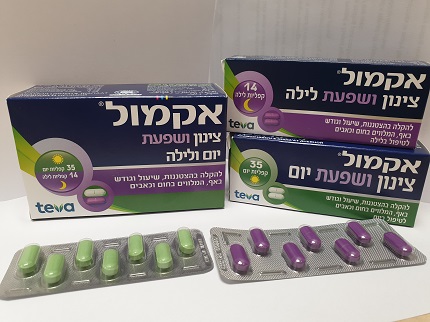Quest for the right Drug

אקמול צינון ושפעת יום ACAMOL TSINUN & SHAPA'AT DAY (DEXTROMETHORPHAN HYDROBROMIDE, PARACETAMOL, PSEUDOEPHEDRINE HYDROCHLORIDE)
תרופה במרשם
תרופה בסל
נרקוטיקה
ציטוטוקסיקה
צורת מתן:
פומי : PER OS
צורת מינון:
קפליות : CAPLETS
עלון לרופא
מינוניםPosology התוויות
Indications תופעות לוואי
Adverse reactions התוויות נגד
Contraindications אינטראקציות
Interactions מינון יתר
Overdose הריון/הנקה
Pregnancy & Lactation אוכלוסיות מיוחדות
Special populations תכונות פרמקולוגיות
Pharmacological properties מידע רוקחי
Pharmaceutical particulars אזהרת שימוש
Special Warning עלון לרופא
Physicians Leaflet
Interactions : אינטראקציות
4.5 Interaction with other medicinal products and other forms of interaction MAOIs (see section 4.3) and/or RIMAs: Pseudoephedrine exerts its vasoconstricting properties by stimulating a- adrenergic receptors and displacing noradrenaline from neuronal storage sites. Since monoamine oxidase inhibitors (MAOIs) impede the metabolism of sympathomimetic amines and increase the store of releasable noradrenaline in adrenergic nerve endings, MAOIs may potentiate the pressor effect of pseudoephedrine. This product should not be used in patients taking monoamine inhibitors or within 14 days of stopping treatment as there is a risk of hypertensive crisis. Do not use if you are now taking a prescription a selective serotonin reuptake inhibitor (SSRI), or other medications for depression, psychiatric, or emotional conditions, or Parkinson's disease, or for 2 weeks after stopping the medication Moclobemide: Risk of hypertensive crisis Sympathomimetic agents: Concomitant use of this product with tricyclic antidepressants or sympathomimetic agents (such as decongestants, appetite suppressants and amphetamine-like psychostimulants) or with monoamine oxidase inhibitors may cause a rise in blood pressure. Antihypertensives: Because of the pseudoephedrine content, this product may partially reverse the hypotensive action of antihypertensive drugs which interfere with sympathetic activity including bretylium, betanidine, guanethedine, debrisoquine, methyldopa, adrenergic neurone blockers and beta-blockers. Cardiac glycosides: Increased risk of dysrhythmias. Ergot alkaloids (ergotamine & methysergide): Increased risk of ergotism Oxytocin: Risk of hypertension Anticholinergic drugs: Enhances effects of anticholinergic drugs (such as tricyclic antidepressants) Anaesthetic agents: Concurrent use with halogenated anaesthetic agents such as chloroform, cyclopropane, halothane, enflurane or isoflurane may provoke or worsen ventricular arrhythmias. Chronic alcohol intake can increase the hepatotoxicity of paracetamol overdose and may have contributed to the acute pancreatitis reported in one patient who had taken an overdose of paracetamol. Acute alcohol intake may diminish an individual's ability to metabolise large doses of paracetamol, the plasma half-life of which can be prolonged. The use of drugs which induce hepatic microsomal enzymes, such as anticonvulsants and oral contraceptive steroids, may increase the extent of metabolism of paracetamol, resulting in reduced plasma concentrations of the drug and a faster elimination rate. The speed of absorption of paracetamol may be increased by metoclopramide or domperidone and absorption reduced by cholestyramine. The anticoagulant effect of warfarin and other coumarins may be enhanced by prolonged regular use of paracetamol with increased risk of bleeding; occasional doses have no significant effect. Caution should be taken when paracetamol is used concomitantly with flucloxacillin as concurrent intake has been associated with high anion gap metabolic acidosis, especially in patients with risks factors (see section 4.4). CYP2D6 inhibitors Dextromethorphan is metabolized by CYP2D6 and has an extensive first-pass metabolism. Concomitant use of potent CYP2D6 enzyme inhibitors can increase the dextromethorphan concentrations in the body to levels multifold higher than normal. This increases the patient's risk for toxic effects of dextromethorphan (agitation, confusion, tremor, insomnia, diarrhoea and respiratory depression) and development of serotonin syndrome. Potent CYP2D6 enzyme inhibitors include fluoxetine, paroxetine, quinidine and terbinafine. In concomitant use with quinidine, plasma concentrations of dextromethorphan have increased up to 20-fold, which has increased the CNS adverse effects of the agent. Amiodarone, flecainide and propafenone, sertraline, bupropion, methadone, cinacalcet, haloperidol, perphenazine and thioridazine also have similar effects on the metabolism of dextromethorphan. If concomitant use of CYP2D6 inhibitors and dextromethorphan is necessary, the patient should be monitored and the dextromethorphan dose may need to be reduced.

שימוש לפי פנקס קופ''ח כללית 1994
לא צוין
תאריך הכללה מקורי בסל
לא צוין
הגבלות
לא צוין
מידע נוסף
עלון מידע לצרכן
21.06.15 - עלון לצרכן אנגלית 21.06.15 - עלון לצרכן עברית 21.06.15 - עלון לצרכן ערבית 11.10.22 - עלון לצרכן עברית 12.12.22 - עלון לצרכן אנגלית 12.12.22 - עלון לצרכן עברית 12.12.22 - עלון לצרכן ערבית 26.09.23 - עלון לצרכן עברית 07.12.23 - עלון לצרכן אנגלית 05.12.23 - עלון לצרכן עברית 06.12.23 - עלון לצרכן ערבית 20.03.24 - עלון לצרכן עברית 17.07.24 - עלון לצרכן אנגלית 17.07.24 - עלון לצרכן עברית 17.07.24 - עלון לצרכן ערבית 01.08.24 - עלון לצרכן עברית 17.08.14 - החמרה לעלון 07.09.22 - החמרה לעלון 11.10.22 - החמרה לעלון 26.09.23 - החמרה לעלון 21.03.24 - החמרה לעלון 01.08.24 - החמרה לעלוןלתרופה במאגר משרד הבריאות
אקמול צינון ושפעת יום